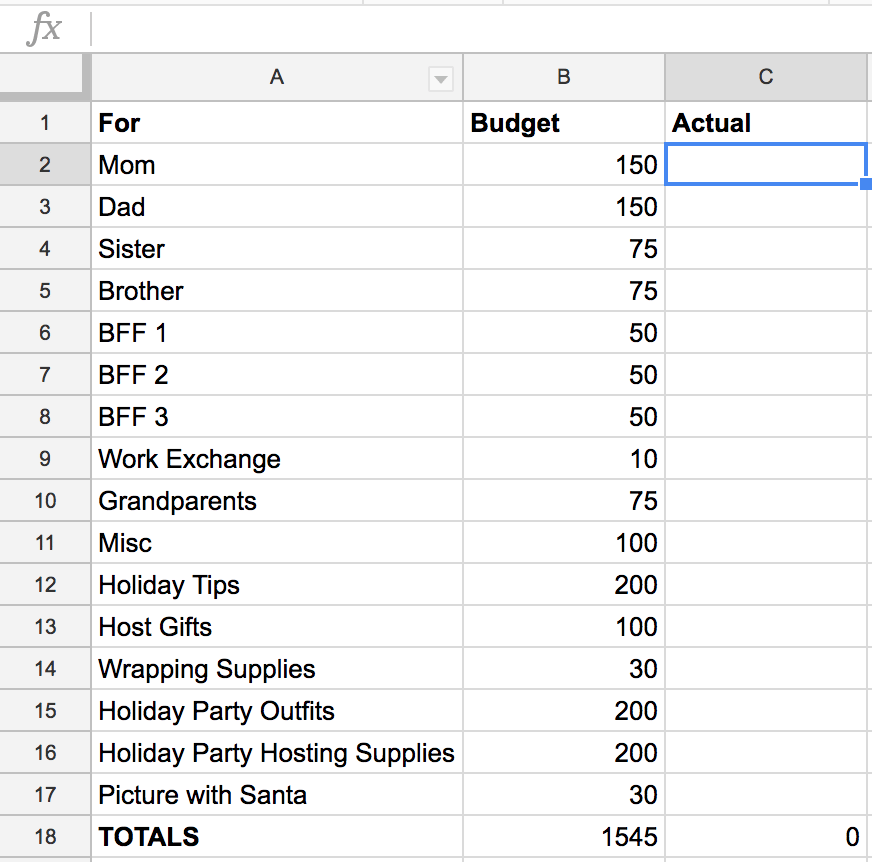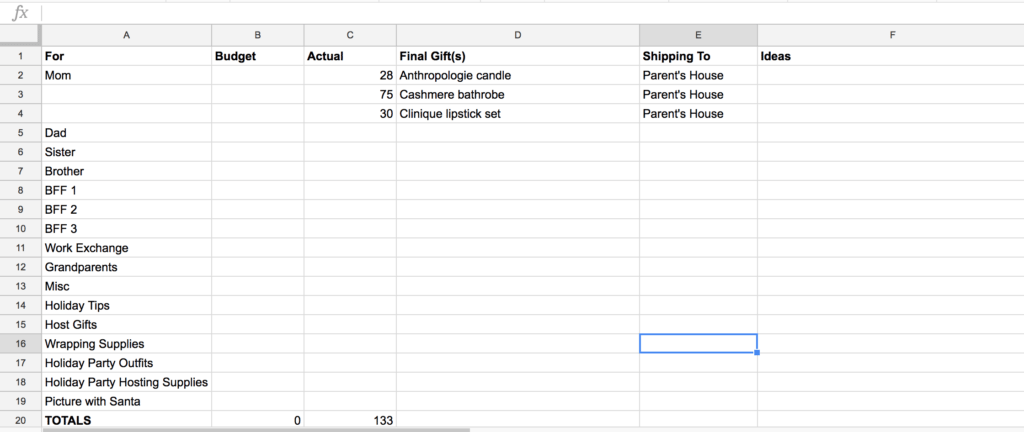How to Make a Holiday Budget
With Thanksgiving in the rearview mirror, it’s officially the start of holiday season. Shopping, parties, wrapping, gift exchanges and more are filling up your calendar, and with it, an unfortunate reality: holiday cheer ain’t cheap.
I can hear some readers in the back yelling at me about how the best parts of the holidays are free, and you don’t have to spend a ton of money on gifts to make your loved ones feel, well, loved. And you’re right!
But in my experience, the holidays are when a lot of budgets completely fall by the wayside and unexpected costs pop up right and left, making it all too easy to say, “I’ll get back on a budget in the new year.”
This post is meant to act as a guideline for accurately predicting and tracking your spending during the holiday season (ugh, have I ever written a more boring sentence?).
Sure, it’s possible to do the holidays on the cheap (and I encourage it). But I want to encourage you to be realistic about what you’re going to need to buy during the holidays and honest with yourself about what you’re going to spend on certain gifts and events. That way, there are no head-slap-inducing surprises when that December credit card bill arrives.
(Want to skip ahead? Download an example holiday budget template here)
Here’s how to start:
Caffeinate up. Grab your laptop. Settle in.
First, I want you to sit down with your laptop open to your bank or credit card statements from last year (if you use a budget tracker like Mint, set the search parameters for November 1-December 31 of last year). If necessary, bribe yourself with a cup of fancy coffee and a Christmas playlist so you don’t feel like a total scrooge.
Next, read through your transactions, taking note of what spending categories they might fit into. Obviously, gift shopping is huge and will probably be the majority of your spending. However, I also make a point to include these categories:
- Holiday tipping: Many apartment buildings collect a holiday fund for staff, and I hate getting caught off guard by that every year. You may also wish to give an extra tip to your hairstylist, your personal trainer, your babysitter – anyone who provides you with a specialty service on a regular basis.
- Wrapping paper and decorations: Somehow, every year, I forget that wrapping paper costs money. Am I alone in this? If you buy a fresh Christmas tree every year or just can’t resist the siren song of Home Goods during the holidays, make sure you’re adding in some cushion.
- Holiday party outfits: If you’ve got a black-tie work party or any other special occasion, go ahead and plan on spending money on an outfit.
- Holiday hosting supplies: Are you the one hosting the party? Silverware, table decor, wine, appetizers… they all cost money.
- Holiday tradition events: Does your family have a special holiday tradition, like ice skating or hot chocolate tasting? Add it to the budget! For me, my friends and I go to Brew Lights every year (best night of the year), and my sister and I get an annual picture with Santa.
- Travel: Woof. It adds up.
Guesstimate your spending.
There are two ways of doing this: by line item or by overall.
For the former, go through each category you’ve listed and estimate how much you’ll be spending on that category. For some items, you might want to break down the categories even further (for example, it’ll probably help to break down the Gifts category by person). Total up each line item, and voila! You have your holiday budget.
If you choose the latter, your move is to choose an overall number you feel comfortable spending during the holidays, then work backwards to determine how much money you want to allocate to each category. This might be a little easier if you’re on a super tight budget; it’s a lot more palatable to cut out holiday spending on clothes or Home Goods impulse purchases if you have a goal number you’re working down from.

Once you have a clear picture of your estimated total spending, take one last look through your budget to see if there are any categories you want to cut back on. Suddenly, $200 allotted to holiday party outfits may not seem so smart.
Track your spending and adjust as necessary.
In my personal budget, I have two columns for spend: one “Budget” and one “Actual.” That way, if I come in under budget on any items, I can quickly see that and reallocate the leftover bucks if necessary. I use good ol’ Google Sheets to track my exact spending and add up all the totals for me (because I am a former Communications major and stereotypically scared of math).
Here’s a major truth of the holiday season: things pop up. For that reason, I build a $100-ish cushion into by budget under Miscellaneous. As I go over in some categories, I’ll pull from the Miscellaneous to keep me on track.
Free tips:
A couple other things to keep in mind for your holiday spending spreadsheet:
- Splitting Christmas between a couple different households? I use this spreadsheet to keep track of where everything is shipping, so I’m not boarding a plane to Kentucky panicking about whether my dad’s gifts are showing up there or in Chicago.
- I also use this spreadsheet to keep track of gift ideas and links to exact product pages, so it’s an easy click once the item goes on sale or I’m ready to purchase.
- It’s gotta be said: This whole process is a lot more fun if you’ve been saving for the holidays for a few months and not spending it all in one lump sum. If this is your first year working with a holiday budget, take note of your final spend. Then, starting early next year, start transferring some extra money from your checking account to your savings, so you’re not stressed over spending a huge amount all in one 30-day span. For example, let’s say this year you spent $1000 all-in on holiday expenses. Starting in July, transfer an extra $200 to your savings account monthly until December to build your holiday spending account.

To help you guys get your budget on, you can click here to download an example of the template I use every year to keep myself on track. Got questions? Leave them in the comments. Happy spending!













